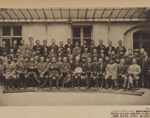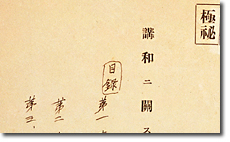HOME > Taisho Democracy > b. The First World War and Japan > Paris Peace Conference
3-7 Paris Peace Conference

Commemorative photograph of Ambassador Plenipotentiary SAIONJI Kinmochi and his retinue after the Paris Peace Conference, taken at the Hotel Le Bristol in Paris, June 1920 (Taisho 9) From "Zuroku Nihon Gaiko Taikan"
World War I ended with the conclusion of the armistice on 11 November 1918 (Taisho 7) between the Allied Powers and the Central Powers. The next year, at the Peace Conference held in Paris, Japan took part as one of the five powers.
The document shown here was found in the papers of MAKINO Nobuaki, who had served as de facto head of Japan's delegation to the Peace Conference, substituting for Prime Minister Plenipotentiary SAIONJI Kinmochi, who, disinclined to take active part, remained in the background on account of "ill-health".
The HARA Cabinet had prepared a list of demands to present at the Peace Conference, including the cession to Japan of all of German held islands in the Pacific north of the equator as well as Germany's rights in the Chinese province of Shandong, in addition to the inclusion of anti-racial discrimination clauses in the League of Nations Charter.
A marginal sideline found in this document alongside the words, "Keeping in step" with the Allies reveals that this goal was equally important as the other demands.
Japan's Policy in Peace Conference
- 1918 (Taisho 7)
- Papers of MAKINO Nobuaki, Document #291-1
- National Diet Library
